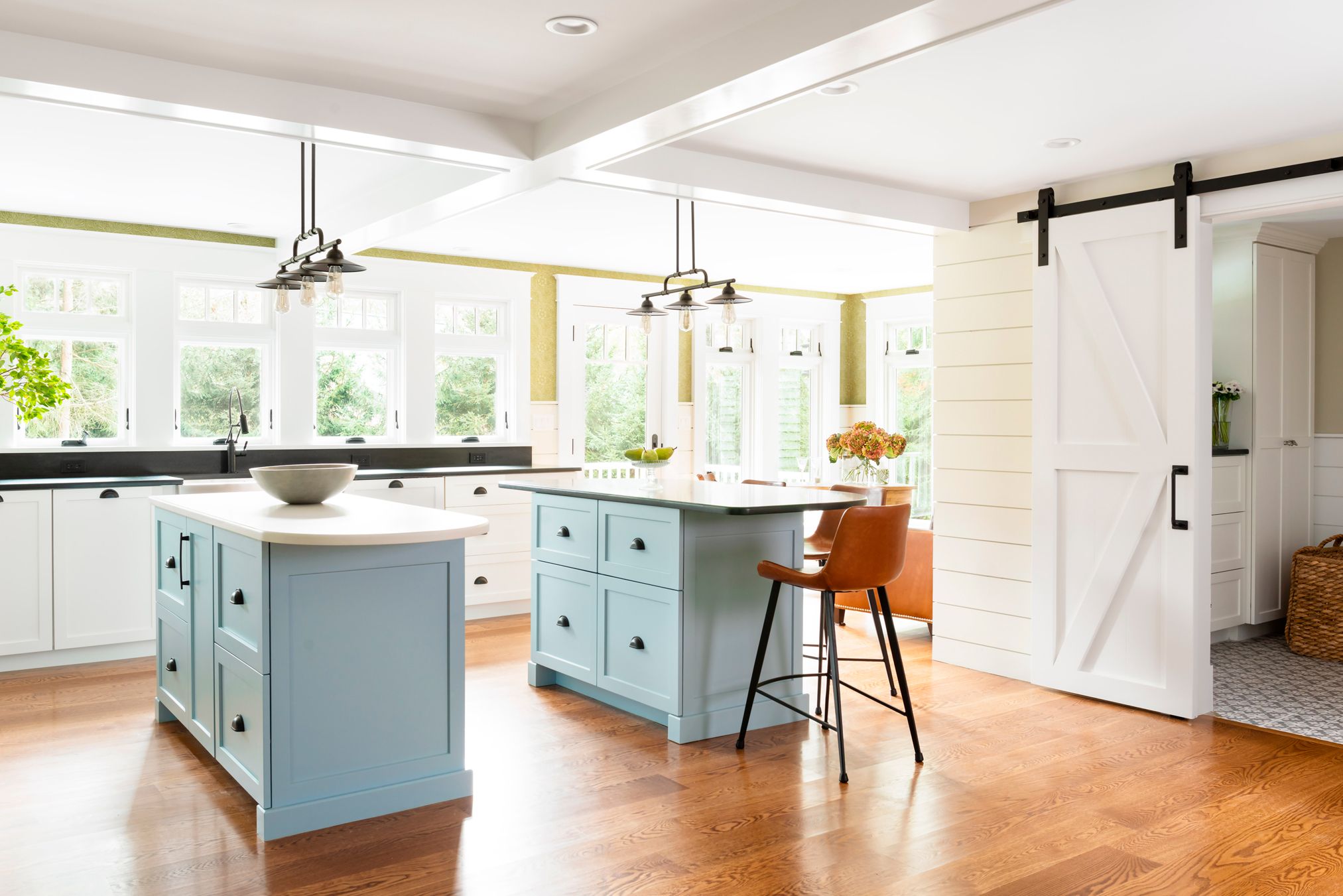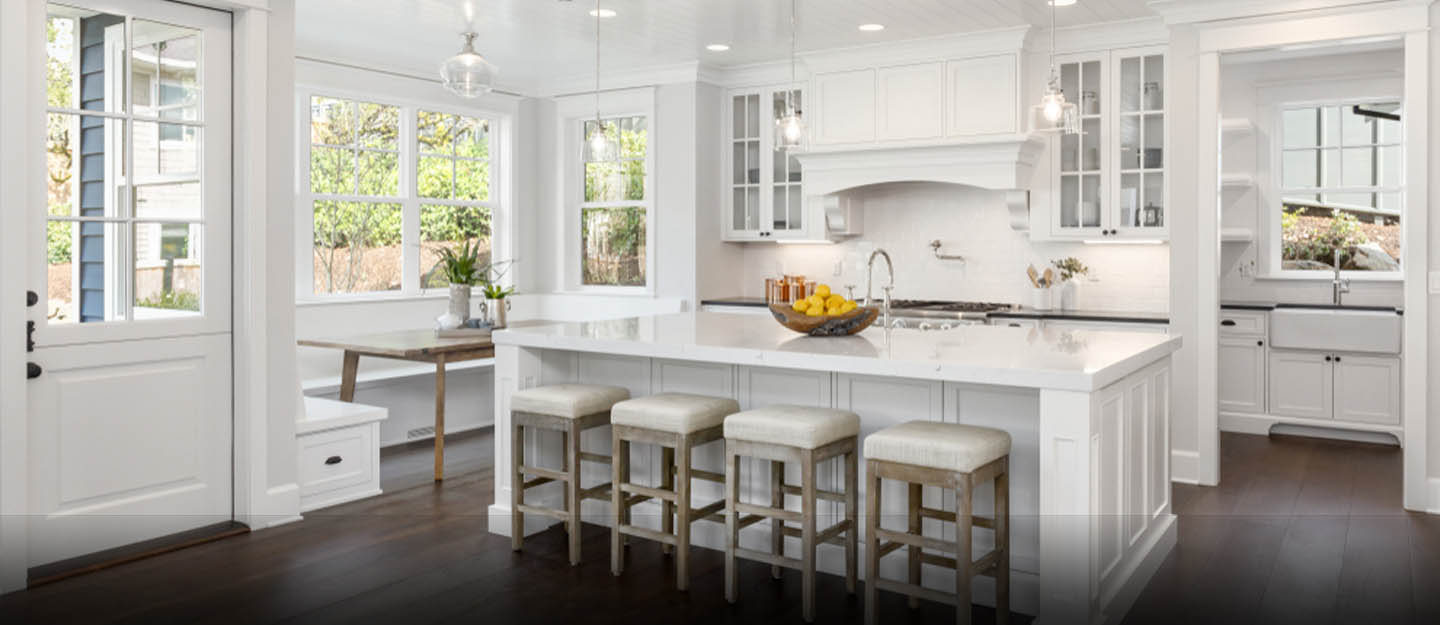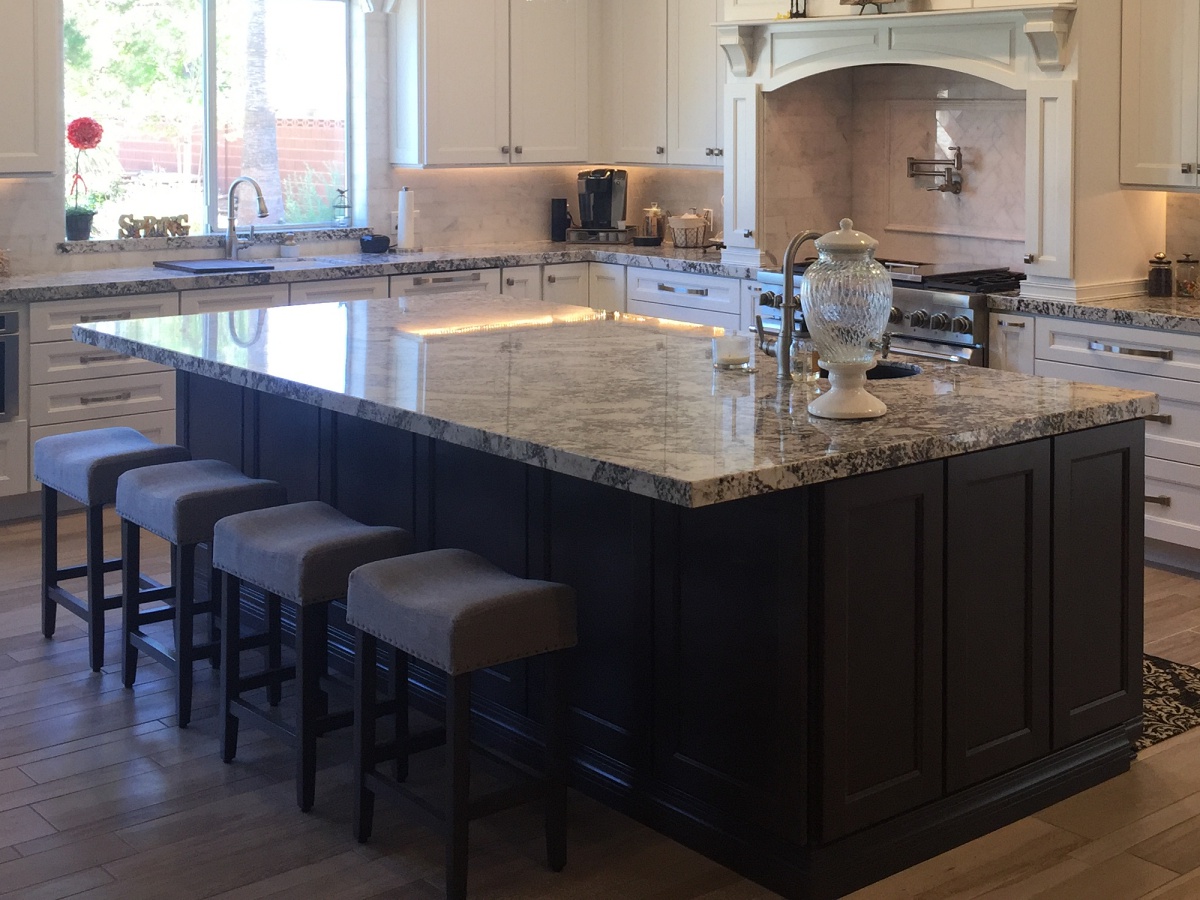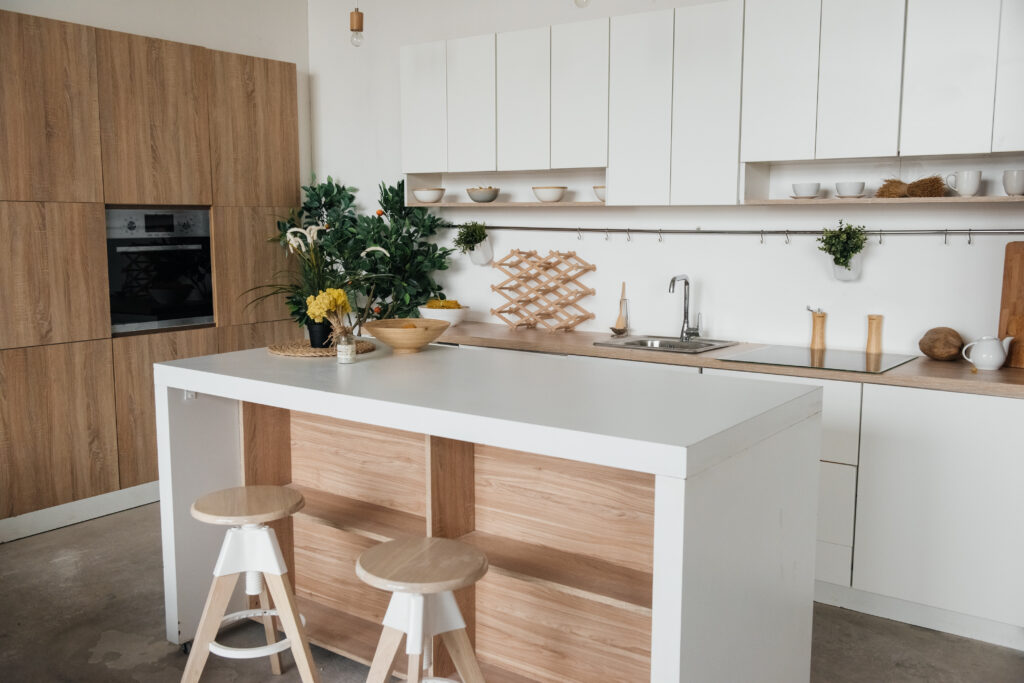As the open floor plan continues to dominate home remodeling trends, more and more of our kitchen renovations include removing walls to create a larger, smoother space. This extra space makes the option to have an island, providing additional storage, work areas, and additional seating in the kitchen.
Many of our islands are also designed with built-in sinks, hobs, dishwashers, or microwave drawers, along with convenient power outlets. With all these benefits, it’s no wonder that kitchen islands are often at the top of our customers’ wish lists!
Adding a Kitchen Island?
While it’s tempting to add an island to your kitchen remodel, there are some realities to keep in mind. Here are some points to consider:
1. Available space
This is not for your natural island but the room around the island. To accommodate typical kitchen traffic, leave 36 – 40 inches on all sides of the island.
This means that there is a maximum of 1.20 meters between the island and the existing discs. Anything smaller will have you running around the island, your other counters, or even other family members trying to navigate the same space.
The second important consideration when designing an island is the amount of space available. Consider both horizontal and vertical spaces above your head when determining the maximum size of your new island.
Vertical space is essential in deciding whether or not an extractor hood should be placed above a hob or pendant lighting and whether or not these features obstruct the view of guests sitting in front of you.
Then natural ventilation and recessed lighting may be better options. Also, make sure that the corridors around your island are neither too big nor too small. In general, 42 to 48 inches is a good range.
Lower than that, and you’ll find the area is too tight to work, more significant, and it will become a hassle moving from one part of your kitchen to another, especially if you’re carrying a heavy roast turkey or hot pan.
2. Functionality

Is it just an island, or are you planning to double up in easy-to-use seats? If you’re hoping to put something like a breakfast bar on this island, then you need to change space. When it comes to adding a seat requirement, you should leave at least two feet of space per seat so that people who eat don’t feel stuffy.
While kitchen islands are known for their versatility, determining a prominent feature for the island space dramatically influences the design. Consider the other elements of your kitchen and what’s missing. Do you already have a work plan with suitable chairs?
Then you probably don’t have to focus on having fun on your island. Do you have enough counter space to prepare and cook your meals? A kitchen island and a kitchen island give priority to different services.
While an island primarily used for cooking will benefit from a stovetop and oven, an island primarily used for food preparation will require a significant amount of counter space.
Does your kitchen have enough space? If your cabinets are full of pots and pans and your drawers are constantly getting blocked by all the kitchen gadgets you’ve put in them, you may need to prioritize storage solutions on your new island.
Whatever problem you are currently facing in your kitchen design, use your new island as an opportunity to solve it. By focusing on the specific use of your island, you simplify the design process.
3. Usability
Not all islands are the same. In addition to the functionality of your island, you will need to consider whether this island meets your needs. Do you find yourself cooking all the time?
Do you prefer to prepare all your meals here? Wash the dishes? Or just a little extra counter space to prepare food when you receive guests? Whatever you use your island, make sure the island is built to fit your lifestyle.
4. Open or Closed Racks

Most islands offer space not only for the counter but also for storage underneath. You can use this space to create additional cabinets or opt for open shelf options to display your tableware.
This depends on your lifestyle: do you have a dog that walks and maybe spills some dishes and breaks them? If so, open shelves may not be the option for you.
5. Extensions
Usually, an island is customized. You can purchase ready-made options, but most islands are built to suit the homeowner’s needs. Now is the time to think about things like built-in cutting boards, dishwashers, electric or USB charging stations, and so on.
There are endless possibilities in this area, and it is essential to consider your extras now as it will be more challenging to add them later.
6. Materials
The materials available for your island are comprehensive, and the only natural way to select both the base and countertop materials is to think about your lifestyle.
Do you have children who can knock things over and stain counters? So choose a material that is not porous and therefore does not absorb the leaked liquid.
Do you spend a lot of time in the kitchen and preparing meals? If so, materials that can be easily damaged or broken will likely stay away.

You can also choose the finish for your shelves and cabinets and most likely get the color that matches your existing kitchen design. Regardless of the invention, material, or extras you choose, there are many benefits to adding a kitchen island.
This will not only add extra space and functionality for your family but will likely grab the attention of potential home buyers if you choose to sell your home in the future.
Function and space considerations determine the size and devices you include on your island, but the materials you choose will determine how they will look.
Choose materials that harmonize with the rest of your kitchen to create a coherent design. Many different materials are available and each has a unique feel. For example, while marble countertops are an excellent addition to bright, white kitchens, granite is a better option for kitchens with lots of colored wood.
The granite itself also comes in a wide variety of different colors and patterns, which should be carefully considered when selecting.
7. Lighting
Where you are active you need light. For islands, this means special lighting – you can’t rely on ambient light to illuminate your workspace, and you don’t have wall cabinets to hide activity lighting as you do elsewhere in the kitchen.
As with most lighting activities, you want the light to come directly to the island. The most common choice is recessed lighting, which is relatively easy if you have standard height ceilings, but more difficult if you have high ceilings.
If the distance between the counter and the ceiling is greater than 6 feet, you should use fixtures or lamps specifically designed to cast the light down rather than diffuse it.
8. Hanging Lighting
Another option is pendant lamps, which hang from the ceiling. However, be careful with this. It’s easy to find them at the wrong height, which could block your view from the island or blind you with a high-intensity light bulb shining directly into your eyes.
Whatever type of lighting you choose, make sure it can be dimmed when you don’t need maximum lighting to operate.
9. Vent Hood
Life would be a lot easier if you could ignore the ventilation of a kitchen island, but you can’t. The most common scheme is to install an exhaust fan behind the hob; on some hobs and cookers, it is integrated into the appliance. This solves the visual problem of a raised hood ruining visual lines.
But even the best exhaust fan cannot cope with the worst of kitchen smells. If you want to miss the smell of fried fish, add a second ceiling-mounted extractor fan. It also helps limit the amount of moisture condensed in the windows in winter if you use a tall pot.

The other option is a ceiling rose that extends to the ceiling. Since it is visible from all sides, it has to be finished (read expensive) and becomes a dominant design element. You can opt for manufactured versions or have a custom extractor finished in almost any material.
The big caveat here: It’s easy for most of a hood, placed low enough to be effective, to spoil the joy of open space above the island.
10. Design
Before designing your kitchen island, it is important to consider what the main purpose will be. Will it mainly serve as a seating area for guests? Will it include appliances to create an efficient layout for the rest of the kitchen? Are you mainly going to use it for preparing food while cooking meals?
If storage is your priority, does your island have shelves, cabinets, or drawers? By determining the functional purpose of your kitchen island in advance, you and your designer can make important decisions such as the size, layout, features, and materials used in the final product.
This is one of the many reasons why it is important to work with a professional design firm when remodeling your home. There are many small details involved that you may not consider on your own that can affect your satisfaction with the renovation of your home. Years to come.
11. Counter Height
Double-height islands can create casual dining spaces, hide dirty dishes, protect non-chefs from splashes and splashes, and make kitchens more interesting. These are the dimensions that make them more comfortable, useful and enjoyable.
The height of your island’s dining area will determine the type of seating you’ll have – a 28 to 30-inch countertop works best with a chair; a standard height 36-inch countertop is best served by a low stool, and a 42 to 48 inch counter requires a bar stool.
12. Cost
On average, a complete kitchen remodels without changing the original footprint will cost between $ 35,000.00 and $ 40,000.00. If you want to remove the walls to expand this kitchen (usually a requirement to add a large island to space), the total cost will be over $ 50,000.00.

Adding an island often requires removing a few walls. It also incurs material costs, such as an extra shelf, carpentry, hardware, paint or stain, plumbing, and any appliances you want to install on the island When you add the human resources.
The time it takes to prepare and install those materials, you add a higher price to your kitchen remodel.
13. Style
There is a lot to consider when designing your kitchen island. If you spend time considering all the factors that create a beautiful space and works well, you will be well on your way to creating an island – and an entire kitchen – that is true for you.
You can almost make an island disappear for those who do not work in the kitchen by extending the “public” side of the island (the one not facing the kitchen) from 4 to 15 cm above the worktop and using the same surface material rest of the interior walls.
Islands that mimic the rest of the kitchen, usually using cabinets with the same finish and the same manufacturer, do not draw attention. Most islands of American cuisine use this scheme.
13. Call The Professionals
For many people, the best way to make sure your new kitchen island is perfect is to call on a professional designer or architect. They will best serve you if you already come to them with an idea of the function, size and materials you would like to see on your island. In addition, images of cuisines and islands that you like will help a designer understand your likes and dislikes, allowing him to create a specific island for you.
Other Tips and Options

If you feel uncomfortable with the reality of installing a traditional island in your kitchen, there are a few alternatives available. While not quite glamorous, cart islands are a popular choice that still offers plenty of perks like storage space and counter space.
- Not only do they take up less space in your kitchen, but many of them are mobile and can be moved around easily if you change your mind in the future. They come in various styles and sizes and can be tailored to fit the rest of your kitchen.
- Another alternative to installing a large island is to have a peninsula instead. Peninsulas act as extensions of your counters and are attached to the perimeter of the room.
- As with islands, peninsulas can provide a valuable counter, seating, and closet space. They also act as great room dividers to separate your kitchen from the adjacent room but still want an open atmosphere.
How to get the right size?
Your kitchen has a unique shape and size, so you need a kitchen island designed to fit it.
Ideally, you want an island that is similar in size and shape to the rest of your kitchen cabinets but has enough space around it to allow you to move freely. The space you allow depends on the type of island you are looking for.

Installation
If you install an island, you will need to hire a kitchen remodeling contractor for your remodel.
There are many benefits to using them in your new kitchen design, such as connecting with good contractors and taking on much of the hard work for you. They can also calculate how big that island should be.
Dimensions
As a general rule, all activity zones should have a space of at least 1-3 meters from each other. This gives everyone in the kitchen enough space to move around, without feeling too distant. You want about 42 inches of space to cross between the counters.
You will need a minimum of 60 inches between the wall and any dining table you install. Again, a designer can tell you exactly how much space you need.
How Can Design Make it Work For Family Life?

Many of the chairs we design for the islands are for children and their visiting friends. When it comes to children, you may prefer to lower the height of the seats on your island to accommodate three or four seats rather than stools.
When chairs are intended for the end of an island, we generally aim to create a 1m x 1m folding table, with four chairs around it. But alternatively, some people prefer to include their lowered table option along the back of an island, like in the photo above.
This creates a longer table, but it is important to plan this option carefully, otherwise, there may be little space left to dine comfortably.

/modern-grey-and-white-wooden-kitchen-interior-1152705690-b1972430558c458e8cc924e765c54ce4.jpg)
